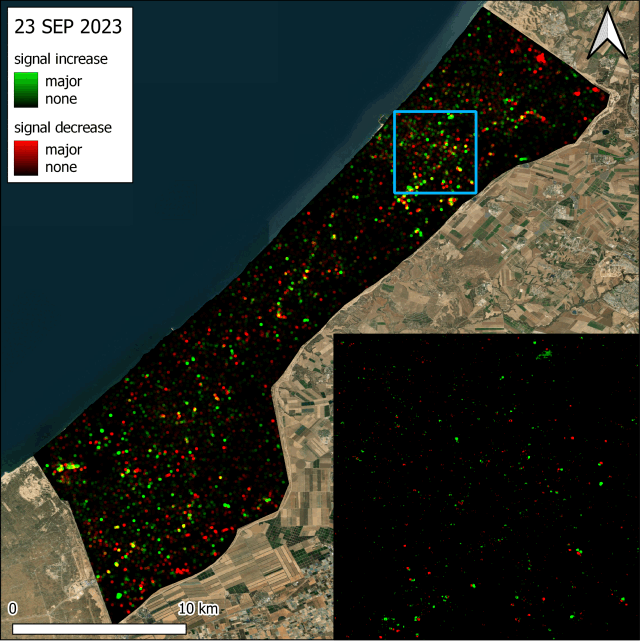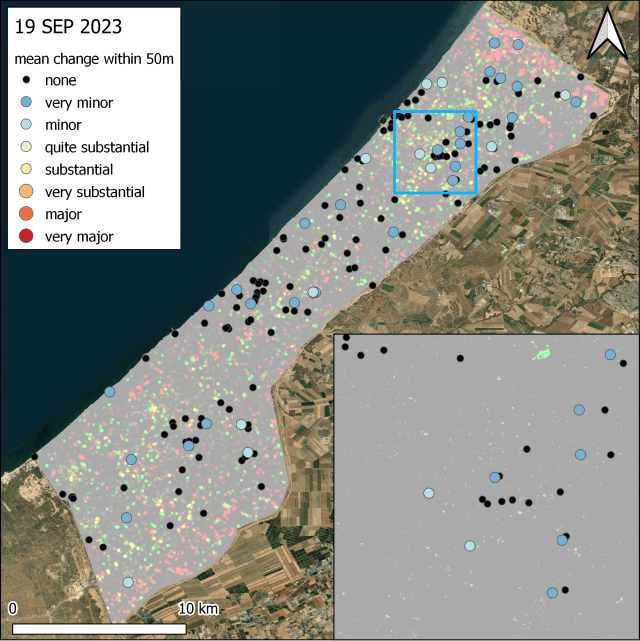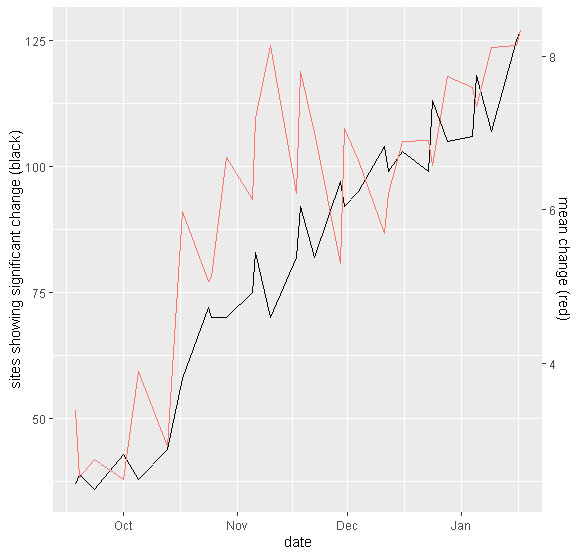Endangered Archaeology in Gaza: an automatic change detection system for archaeological sites and built heritage
With the ongoing conflict in Gaza causing catastrophic damage to buildings, infrastructure and – most importantly – the lives of the innocent people caught up in it, the archaeology of this historically significant area is also receiving irreparable damage. To help track affected sites in near-real time, EAMENA has developed an automatic change detection (ACD) system using Google Earth Engine (GEE). This builds on work already carried out by the project (Rayne et al. 2020). The original tool, which is currently undergoing major development by our Leicester team, utilises Sentinel-2 multispectral satellite imagery. However, because of the heavily urbanised nature of the Gaza Strip, for the new system Sentinel-1 Synthetic Aperture Radar (SAR) data is being deployed. SAR uses radio waves to map the Earth, rather than visible/infrared light, and is particularly effective at detecting buildings. The same datasource has been employed by the BBC ( 2024) and the Guardian (de Hoog et al. 2024) to map urban destruction in Gaza.

Gaza’s urban areas are easier to spot in the SAR image (right, where they show up as yellow) than the true colour image (left, where they show up as white/grey). Sentinel-1 and Sentinel-2 composites from 09-11/2022, data courtesy of the ESA.
The technical workings of the new GEE ACD script will be reported in more detail in a future publication. However, essentially, it compares two SAR images and highlights areas where there are differences between them. Buildings reflect radar very strongly, so significant structural damage would lead to a significant drop in the signal. Conversely, bare earth reflects radar signal poorly, so the appearance of rubble, large vehicles or temporary structures will show an increase in signal. The ACD script generates a new image showing where there are major differences in the readings, and whether this represents a drop or an increase in signal. A time series of the change images are shown below. In each case, a median image centring on each date given (the ‘after’ image) is compared to another median image calculated using all available images from August 2023 (the ‘before’ image). Every ‘after’ image is compared to the identical August ‘before’ image - the results are not cumulative.

Automatically detected change over time in the Gaza strip and Gaza town (inset). The dates given are approximate as median composites are calculated from three images centring on the date shown. The small scale image is a focal mean of the detailed (inset) data - yellow/orange patches show areas where both signal increase and decrease have occurred.
These results are then compared to the locations of known archaeological sites in Gaza recorded in the EAMENA database (Andreou et al. 2022). Any sites where change is detected within a fixed buffer area of 50m from their centre are flagged.

Mean change detected at archaeological sites over time in the Gaza Strip and Gaza town (inset).
It should be stressed that this script detects any change happening in the vicinity of the sites – whether or not it is related to the conflict. Thus change is detected around sites before 07/10/2023. In urban areas, for example, this may be the result of significant differences in the volume of traffic, while in agricultural areas it may be related to variation in crops and vegetation.
However, it is clear that the volume and magnitude of change increases significantly at the start of the conflict, and builds steadily as it has progressed. This can be demonstrated graphically, looking specifically at the archaeological sites. Although change was detected at around 40-50 sites prior to the conflict, it is at a low level, only just reaching the threshold for being flagged. As the conflict has progressed, the number of sites being flagged, and the magnitude of the change recorded in their immediate vicinity has risen sharply.

Graph showing the number of sites being flagged (black line), and the magnitude of the change being recorded for each site on average (red line) over time between September and January.
As of the middle/end of January 2024, between 97 and 117 sites (i.e. 58-70%), of the 166 that are currently in the EAMENA database, are being flagged by the ACD script. Although the nature of the data being used makes it impossible to provide a definitive list of damaged and destroyed sites, the conflict is clearly taking a heavy toll on Gaza’s cultural heritage.
The next step will be to compare these ACD results to the data collected on the ground, for example by Heritage for Peace (Heritage for Peace, 2023).
References
Andreou, G.M., Fradley, M., Blue, L. and Breen, C. 2022. Establishing a baseline for the study of maritime cultural heritage in the Gaza Strip, Palestine Exploration Quarterly https://doi.org/10.1080/00310328.2022.2037923.
Heritage for Peace, 2023. Report on the Impact of the Recent War in 2023 on the Cultural Heritage in Gaza Strip - Palestine. Unpublished report produced by Heritage for Peace. November 7th, 2023. https://www.heritageforpeace.org/wp-content/uploads/2023/11/Report-of-the-effects-of-the-last-war-of-2023-on-the-cultural-heritage-in-Gaza-Strip-Palestine-english.pdf.
de Hoog, N. Voce, A., Morresi, E., Ganguly, M. and Kirk, A. 2024. How war destroyed Gaza’s neighbourhoods – visual investigation. The Guardian 30/01/2024. https://www.theguardian.com/world/ng-interactive/2024/jan/30/how-war-destroyed-gazas-neighbourhoods-visual-investigation.
Palumbo, D., Abutaleb, A., Cusiac, P. and Rivault, E. 2024. At least half of Gaza's buildings damaged or destroyed, new analysis shows. BBC News 31/01/2024. https://www.bbc.co.uk/news/world-middle-east-68006607.
Rayne, L., Gatto, M., Abdulaati, L., Al-Haddad, M., Sterry, M., Sheldrick, N., & Mattingly, D. (2020). Detecting Change at Archaeological Sites in North Africa Using Open-Source Satellite Imagery. Remote Sensing, 12(22), 3694. https://doi.org/10.3390/rs12223694.



